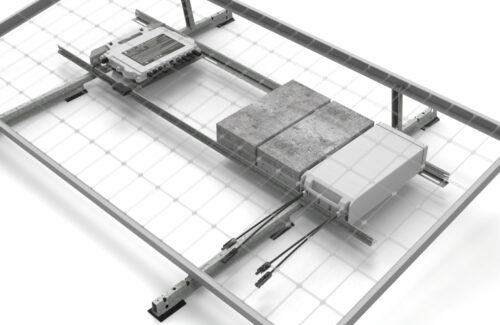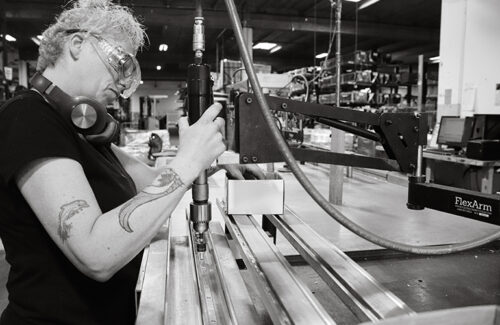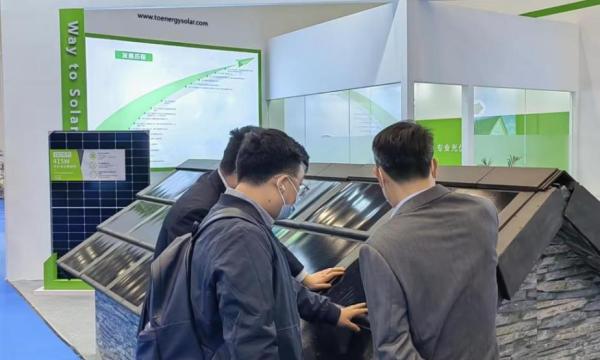这个三米长的原型包括九个基于铝化合物的面板。外墙的光伏元件可以倾斜以捕获更多的阳光。

外墙的开发人员提出了三种将光伏面板嵌入混凝土外壳的技术。
图片:A。Heller,ai:L der HTWK莱比锡
摘自德国pv杂志。
德国的弗劳恩霍夫硅光伏中心(CSP)和应用科学,技术与商业大学(HTWK)莱比锡已开发出一种太阳能立面,他们声称其性能优于目前的垂直建筑集成光伏(BIPV)装置。
德国系统由莱比锡HTWK科学家设计,并由Fraunhofer CSP同行实现,其光伏元件可倾斜以捕获更多的阳光。Fraunhofer CSP项目经理塞巴斯蒂安·辛德勒(Sebastian Schindler)说:“与固定在建筑物墙壁上的平面太阳能模块相比,集成在该立面中的光伏元件可提供高达50%的收益。” “门面看起来也不错。”
这个三米长的原型具有九个安装在铝化合物中的面板。
开发人员还想出了一种将PV集成到混凝土外墙中的方法,特别是专门设计的碳混凝土-该碳混凝土在硬化时吸收二氧化碳,从而减少了其净碳足迹。
碳素混凝土
两家机构的研究人员都与德累斯顿工业大学的员工一起研究了三个概念。辛德勒说:“在Fraunhofer CSP,我们研究了如何最好地将光伏元件连接到这样的碳混凝土外墙,如何将新型混凝土与太阳能发电最佳地结合在一起。”
一种解决方案是将光伏元件集成到外墙中,将太阳能电池组件直接倒入混凝土中或层压或胶合到混凝土板上。但是,也可以通过按钮,螺钉连接或其他紧固方法来安装模块,从而使维护和维修工作更加容易。辛德勒说:“我们能够证明这三个固定选项在技术上都是可行的。”

合适的解决方案
确保光伏面板适合混凝土是研究人员面临的挑战之一,他们还必须注意不要将模块拧入混凝土的薄区域或含碳纤维的表面。
提出设计方案的学者们正在研究他们从11月开始的SOLARcon:Concrete Facades 2.0项目下的商业版本。
同时,将在不同的天气条件下测试原型设备的光伏组件和混凝土部分,并进行加速老化测试。还计划进行仿真,以检查混凝土和PV元件的连接点在高温下如何加热,以及组件在大风和高压载荷下的行为。
原文:
From pv magazine Germany.
Germany’s Fraunhofer Center for Silicon Photovoltaics (CSP) and the University of Applied Sciences, Technology and Business (HTWK) Leipzig have developed a solar facade they claim out-performs current vertical building-integrated PV (BIPV) installations.
The German system, designed by HTWK Leipzig scientists and realized by their Fraunhofer CSP counterparts, features PV elements which can be tilted to capture more sunlight. “The photovoltaic elements that are integrated in this facade provide up to 50% more yield than planar solar modules attached to building walls,” said Sebastian Schindler, project manager at Fraunhofer CSP. “And the facade also looks good.”
The three-meter prototype features nine panels mounted in an aluminum compound.
The developers also came up with a method of integrating PV into concrete facades, particularly specially-designed carbon concrete – which absorbs carbon dioxide as it hardens, reducing its net carbon footprint.
Carbon-eating concrete
Researchers from both institutions worked with staff from the TU Dresden university on three concepts. “At the Fraunhofer CSP, we investigated how best to attach photovoltaic elements to such carbon-concrete facades – how to optimally combine the new type of concrete with the generation of solar power,” Schindler said.
One solution was to integrate the PV elements into the facade, with solar modules either poured directly into the concrete or laminated or glued to concrete slabs. However, it is also possible to attach the modules with push-buttons, screw connections or other fastening methods, making maintenance and repair work easier. “We were able to show that all three fastening options are technically feasible,” said Schindler.
A fitting solution
Ensuring the PV panels fit into the concrete was one of the challenges faced by the researchers, who also had to be careful not to screw modules into thin areas of concrete or surfaces containing carbon fibers.
The academics who came up with the design are now working on developing a commercial version under the SOLARcon: Concrete Facades 2.0 project they started in November.
In the meantime, the PV components and concrete sections of the prototype installation will be tested under different weather conditions and exposed to accelerated aging tests. Simulations are also planned to examine how the concrete and PV element connection point heat up in high temperatures and how the modules behave under high wind and pressure loads.












